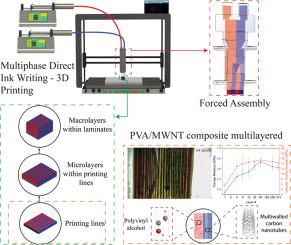Additive Manufacturing ( IF 11.0 ) Pub Date : 2021-09-16 , DOI: 10.1016/j.addma.2021.102322 Dharneedar Ravichandran 1 , Weiheng Xu 1 , Mounika Kakarla 2 , Sayli Jambhulkar 1 , Yuxiang Zhu 1 , Kenan Song 3

|
Additive manufacturing has advantages in freedom of design, rapid prototyping, and waste minimization. However, one bottleneck in 3D printing polymer/nanoparticle composites has been the lack of high-precision structural control, especially without sacrificing manufacturing rates. For the first time, this study demonstrated the design and development of a new additive manufacturing mechanism, the Multiphase Direct Ink Writing (MDIW). By matching the viscosity between polymer solutions/nanoparticle suspensions, an individual line composed of a desirable number of sublayers (i.e., 4, 8, 16, 32, 64, 256, 512) was printed. A thin-ply structure with continuous ink deposition showed a strong dependence upon these layer numbers per printing line or the unit layer thickness. The 64-layered structure showed the highest modulus, strength, and energy absorption at a specific strain of 30% (E30% strain) (i.e., 5 times increase in Young's modulus, 3 times growth in ultimate tensile strength, and 3.5 times improvement in E30% strain compared to the PVA). The enhancement in composite mechanics was due to thin layer thickness that improved the interfacial interactions and nanoparticle distribution homogeneity. The interfacial interactions between layers also facilitated the nanotube alignment and affected the crystallization behaviors. Our MDIW method is compatible with natural-, synthetic- and biopolymers as long as the feedstock rheology is well-managed, showing broad applications in structural systems, thermal insulation, electrical conductivity, optical reflectance, and biomedical scaffolds.
中文翻译:

用于多层聚合物/纳米颗粒复合材料的多相直接墨水书写 (MDIW)
增材制造在设计自由、快速原型制作和减少浪费方面具有优势。然而,3D 打印聚合物/纳米颗粒复合材料的一个瓶颈是缺乏高精度的结构控制,尤其是在不牺牲制造速度的情况下。这项研究首次展示了一种新的增材制造机制的设计和开发,即多相直接墨水书写 (MDIW)。通过匹配聚合物溶液/纳米颗粒悬浮液之间的粘度,打印出由所需数量的子层(即,4、8、16、32、64、256、512)组成的单条线。具有连续油墨沉积的薄层结构显示出对每条印刷线的这些层数或单位层厚度的强烈依赖性。64层结构表现出最高的模量、强度、30% 应变)(即与 PVA 相比,杨氏模量增加 5 倍,极限拉伸强度增加 3 倍,E 30% 应变增加3.5 倍)。复合材料力学的增强是由于薄层厚度改善了界面相互作用和纳米颗粒分布的均匀性。层之间的界面相互作用也促进了纳米管的排列并影响了结晶行为。我们的 MDIW 方法与天然聚合物、合成聚合物和生物聚合物兼容,只要原料流变学得到妥善管理,在结构系统、隔热、导电、光学反射和生物医学支架方面具有广泛的应用。



























 京公网安备 11010802027423号
京公网安备 11010802027423号